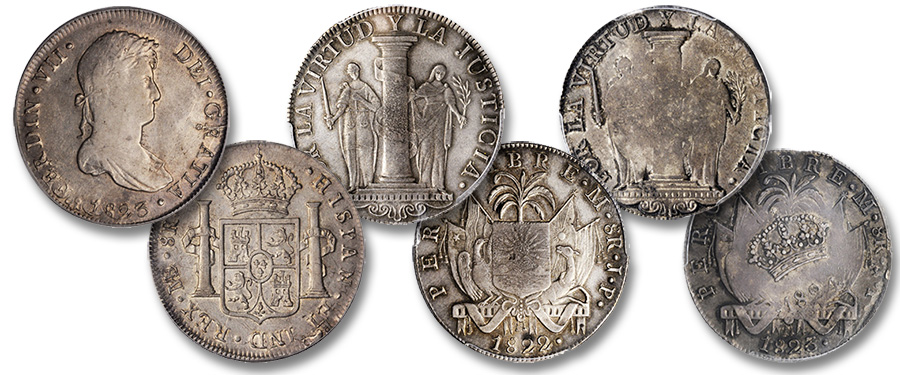
With the holiday season coming into full swing and the 2020 New
Year right around the corner, anticipation for our Official Auction of the 48th
Annual New York International Numismatic Convention is building. The auction
will take place January 17-18 at the Grand Hyatt Hotel in Midtown Manhattan. It
will offer many highly sought after treasures from varied locations and time
periods. This week, we feature a few items from the “Kyle Ponterio Collection
of Cut and Countermarked Coins,” struck during Peru’s War for Independence.
The former Spanish colonies of Latin America saw many
changes in the early part of the 19th century, going from repressed
colonial subjects under harsh conditions and heavy taxation to newly formed Republics
of freed peoples. For many, the transition came at an exorbitant price, with
much loss of life and destruction over many years. A great deal of havoc was
wreaked during Peru’s fight for Independence, with the capital city of Lima changing
hands multiple times and the mint ultimately being destroyed.
Peru was considered by many to be Spain’s most important
colony of South America, and the mint at Lima had been in continuous operation
since 1684. Spain concentrated her best efforts on governmental and military
forces by making Peru the center of the colonial government for the
Captaincy-General of Peru. Those efforts came to a close following the decisive
battles of Junin (August 6, 1824) and Ayacucho (December 9, 1824), both
revolutionary victories. Toward the end of this conflict, the “City of Kings,” as
Lima was also known, switched between Royalist and Insurgent control several
times—something that can be observed numismatically. Republican coinage was
authorized to be struck by the Supreme Decree of July 15, 1822, with issues bearing
the provisional arms of the state along with the inscription “PERU LIBRE” on
the obverse and “POR LA VIRTUD Y LA JUSTICIA” on the reverse. Two varieties are
known for each date of the new Republican issues, namely with “Short Tassels”
or “Long Tassels” above the date.
Issued for less than a year, the new Republican coinage
ended prior to June 17, 1823, when Royalist forces reoccupied the virtually
defenseless city as their Republican counterparts fled Lima for other parts of
the country. The Royalist forces had control of the city for about one month
and, during that time, a small quantity of Insurgent 8 Reales were discovered
at the mint and subsequently overstruck with colonial dies bearing the date
1823 and the effigy of Ferdinand VII. On some of these issues, remnants of the Insurgent
host coin can be seen and identified. The following month, the Royalist forces
left the city, taking with them most of the minting equipment and sending it to
the fortress Real Felipe in Callao. They set fire to the mint in an attempt to
destroy the remaining machinery.
In early 1824, Royalist forces again gained control of the
capital city and produced more 8 Reales of Ferdinand VII, but most efforts were
concentrated on the countermarking and authorizing of the 1822 and 1823
Insurgent issues. According to the May 6, 1824 Decree, citizens were given a
maximum of eight days to bring their coinage to the mint for authorization or
face its seizure. It is apparent by the amount of surviving Insurgent issues
left unmolested that many citizens did not comply with the decree. In any event,
Peru’s War for Independence led to the first Republican issues and paved the way
for the foundation of the newly Independent country.
Though the consignment deadline for our NYINC
2020 auction has passed, we are always looking for attractive, interesting, and
valuable material to be featured in our showcase auctions as well as our Collectors
Choice Online (CCO) sales. If you are interested in consigning your coins and
paper currency (whether a whole collection or a single rarity), contact one of
our consignment directors today at 800-458-4646 or visit our website
StacksBowers.com.





